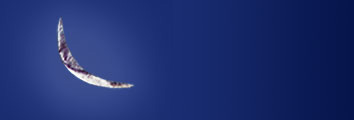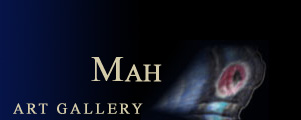|
|
| |
|
|
| |
|
| |
Biography
Lashai's painting is at once tender, brusque, indecipherable, and calligraphic. Color fields that often predominate her canvases, obscure margins and diminish a sense of surface. Her latest works, exhibited at Mah Gallery, bear flat layers of color- a surprising blue in one instance- that conjure infinity in the background.
Her works are less concerned with surface treatment as they are with the seemingly unrestrained invasion of line. Though the viewer is inclined to interpret the invasive forms as elements of nature, they are ultimately abstract. The surface aberrations defy placement, fusing into abundant free lines in the compositions, in some cases so dense as to fill the background, in others so absent as to evoke hollow, infinite vacuity.
Urgency and chaos are constant in Lashai's work. Often one feels confronted by a wayward literary piece's disregard for grammatical convention. But free yourself from the quest for subject and with aid of the senses and imagination arrive at the more profound. Lashai's frenzied lines inhabit obscured vastness and reflect the artist's naturally scattered mentality- so of course they fail systemic interpretation! Comprehension of Lashai's secret universe requires levity of spirit- the willful submission to chaos. In this manner, a composition seemingly out of the artist's control is primed for the series of revelations by which we read abstraction.
Imparting scattered lines to surfaces has always been a manifestation of the inner world, a type of psychological purging. We all indulge this ancient habit when scribbling absently, despite our efforts to rarify it. Artists merely cultivate an intrinsic human tendency. A painting is a reflection of the artist's personal wishes and inner feeling; Lashai does not vie for dignity or majesty, only at best expressing a fleeting instant in and against time.
Abstraction is a representation of dual discovery. The artist does not strive for legibility, and the viewer, with signs and figures failing, is able to create a personal course of interpretation.
The sketching elements of Lashai's work, whether reminiscent of figures in nature, or skewed alphabetical characters, have precedent in the history of abstract expressionism. In Robert Motherwell, Hans Hartung, and Mark Tobey we often see decomposed characters and informal drawing elements contributing to a non-literary narrative and composition. The electrified lines in Lashai's works have an informal quality that recalls the thunderous uninhibited invasion of pen strokes on an unidentified surface.
Lashai, with comparably greater lyricism employs color fields and lines, not for intellectual signification, but to evoke the ecstatic mirth and enchanting existence of nature. Graphic impressions in her work move between unconscious line and the artist's nimbleness in minimizing natural form. Her figurative genius is in this playful wavering between constructed spaces and uncontrolled strokes, enrapturing the viewer in perpetual joy. Lashai is not making a statement on the language of painting, nor does her work require affirmation, rather she creates a pretext for ascending into realms outside our deafening world. Her works are always an opportunity to visit an inner, utterly foreign, universe and to encounter unlikely and exhilarating elements of life. Her work can convince a viewer that such profundity and gratification is best attainable through the medium of painting.
But initially, Farideh Lashai does look like a naturalist painter. In most of her works the footprints of nature can be traced, a tendency she herself recognizes:
��Nature stimulates the primary sense and the essence of life in me, a sense that we experience in love. The projection of myself to nature arouses the ecstasy of existence in me, and in this way I connect to inner elements.�
Interview with Farideh Lashai, the Haft Magazine, No. 19, March 2005
Like an itinerant soul, nature is the base to which she continually returns, a nostalgically reference point. The result is a childlike fear and enamorment with the natural world that mirrors nicely the creative authenticity and freedom in her work- achieving an effervescent power that surpasses many of her contemporaries. But unlike other large expressionist paintings, Lashai's works do no generate anxiety and unease in the viewer, rather having passed through life's sufferings their creator imbues them with reverence for nature's ability to conjure the infinite.
|
| |
|
| |
Solo Exhibition
1968 Milan, Italy, Gallerie Duomo
1968 Selb, Germany, Studio Rosenthal
1973 Tehran, Iran, Sayhoon Gallery
1974 Tehran, Iran, Tehran Gallery
1976 Tehran, Iran, Tehran Gallery
1977 Khoozestan, Iran, Cultural Center of the National Iranian Oil Company
1984 Bakers Fild, USA, Clark Gallery
1987 Basel, Switzerland,Gallery Demenga
1987 Lavalta, Malta, National Museum of Fine Arts
1987 Tehran, Iran, Classic Gallery
1987 Tehran, Iran, Golestan Gallery
1988 Dusseldorf, Germany, Libertas Gallery
1988 Basel, Switzerland, Gallery Demenga
1988 Mamut Lake, USA, Art Gallery
1990 USA, Berkeley University
1990 London, England, Hill Gallery
1992 Tehran, Iran, Golestan Gallery
1993 Dusseldorf, Germany, Gallery Aum Hufeisen
1994 Tehran, Iran, Golestan Gallery
1995 Pau, France, Gallery Nouste Henric
1996 Tehran, Iran, Golestan Gallery
1997 Laudun, France, Gallery Ch'teau Lascours
1998 Tehran, Iran, Goletsan Gallery
|
| |
|
| |
Group Exhibition
1968 Ostend, Belgium, International Young Artists
1971 Tehran, Iran, International Exhibition of Tehran (as a member of the Austrian Pavilion)
1973 Tehran, Iran, Iranian Women Artists International Exhibition of Tehran
1975 Tehran, Iran, Four Women Artists Exhibition, Iran - America Society
1978 Basel, Switzerland, International Exhibition
2008 Mah Art Gallery, An Impressive Representation by 50 Artists - Tehran
|
| |
|
|



